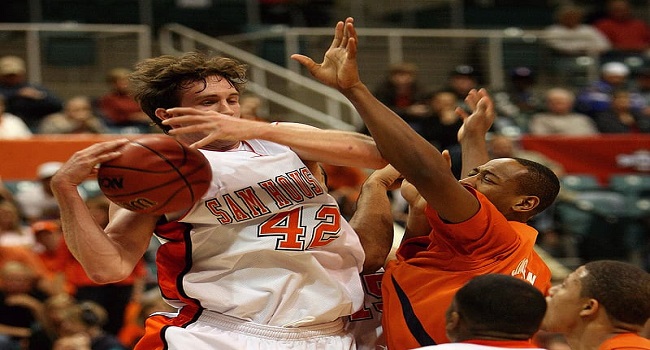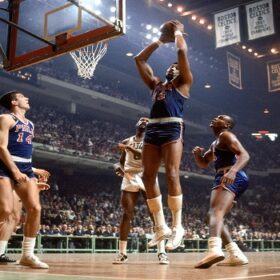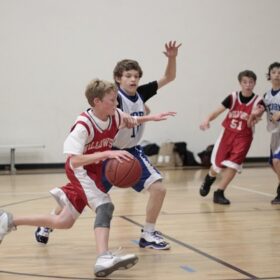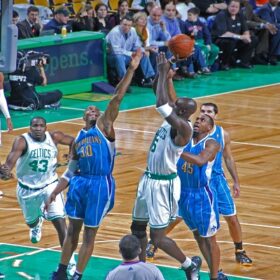If you are fond of basketball, you most probably are familiar with various terminologies like restricted area, charge and carry, etc. which implies various rules and penalties in basketball. One such rule is “Carry” in basketball.
Some famous basketball players like Michael Jordan, Isaiah Thomas, and Allen Iverson had the allegations of “Carrying the Ball,” and the referees in NBA let them free. But the question here is, what is carrying in basketball?
If you are thinking carrying is holding the basketball while playing, then you are wrong because carrying is a much wider concept and implies a violation of the rule in basketball.
And most of the basketball fans are still unaware of it because, in present games, this terminology and violation are not used very often by the refs.
Quick Definition
Carrying is also means turning the ball over or palming the ball. Basketball fans around the globe still debate over the definition of carrying in basketball. And different leagues throughout the world define carry in different ways.
Basically, carrying is a violation of the rule in basketball. The carrying violation occurs when the basketball comes at a momentary rest, and the player handling the ball still continues dribbling or moving his feet.
This happens when the player handling the ball while dribbling puts his hands on the lower half of the ball or put his hands in a way beneath the ball, which causes momentary rest in the ball. The player can not continue dribbling or moving his feet if the player prevents the ball from going down or push the ball upward.
The referees in the NBA have their own ways of spotting a carry in basketball. Some examples of carrying called by the NBA referees are as follow:
- The NBA refs check the dribbling player’s palm. If the player has its palm faced upward towards the sky, then the referee will most likely call a carry.
- A player can dribble the ball alongside the court in basketball. It gives a better direction and control to the ball. But the players should make sure their hands do not slide far below the side of the ball.
- The referee will call carry if players have their hands on the plane of a ball at a lower than 180 degrees.
- Where the player stations his hands for a longer period and stops the motion of the ball, referees will also call a carry in such a situation.
The Difference Between Carry-Double-Dribble And Carry-Traveling
The carry-double-dribble and carry-traveling are part of the same carry violation but are different on the basis of the ball handler’s violation of the rule. Many reasons can cause carry-double-dribble and carry-traveling basketball infringements.
In a carry-double-dribble, the referee is of the view that the player has stopped dribbling while he begins to carry the ball. While on the other hand, in a carry-traveling, the player keeps moving his feet when he is carrying the ball.
The details of both the carry-double-dribble and carry-traveling are as follow:
Carry-Double-Dribble
Carry-double-dribble is one of the most common carry violations in basketball. The carry-double-dribble occurs when the player handling the ball while dribbling puts his hands on the lower part of the ball, which causes rest in the ball.
After the ball is at rest position, if the player handling the ball continues to dribble, then it is will be in the violation of carry. A ref may also call a carry double dribble when the player stops dribbling and then starts it again after the carry.
When double dribble occurs, the player carrying the ball gets penalty with a turnover, and the ball will come in the possession of the rivals. l.
Carry-Traveling
The carry traveling occurs when the player holding the ball puts his hand on the lower half of the ball, and it causes rest in the ball while the player keeps moving.
In carry traveling, the player may continue to move their feet instead of continuing to dribble. The call for traveling completely depends on the referee.
However, the carry traveling has the same consequences as the double dribble, the player carrying the ball gets a penalty with a turnover, and the opponent team will have the ball.
History Of Carry Violation In Basketball
Different rules in the basketball were introduced at various occasions, sometimes considering the players’ safety and sometimes for its improvement and making it a fair game. In the past, Dr. James Naismith did not allow dribbling in his original 13 rules of basketball. In basketball rules, players can not run with the ball in their hands at all. This rule changed after 1910, after which the players were permitted dribbling the ball, but the basketball players were still not allowed to shoot the ball. However, after 1916, the rules changed, and the players were allowed to dribble the ball and shoot it.
On the other hand, the traveling rule has also gone through some changes since its inception. Before 2018, the steps involved in traveling were two, which means that a traveling foul would incur if the player would take more than two steps without dribbling the ball. But FIBA changed this rule and increased one more step and made it of three steps.
Conclusion
It is extremely difficult for the referees to spot carry during a game. The players are very masters at their work, and they can easily mislead the referee through their expertise. Players use different moves for carrying. One of such legal moves is “hesitation,” in which the players would move as if they are picking dribble but continue to dribble and get to the basket. If the player takes too long in hesitation, the referee can call a carry.
A carry is most likely to be experienced in professional games because, in school and college level games, the rules are not much strict, and the players are free to play without worrying about rules like carrying. But in professional games, the rules are strict, and the players usually avoid such mistakes that can lead to a carry penalty.






